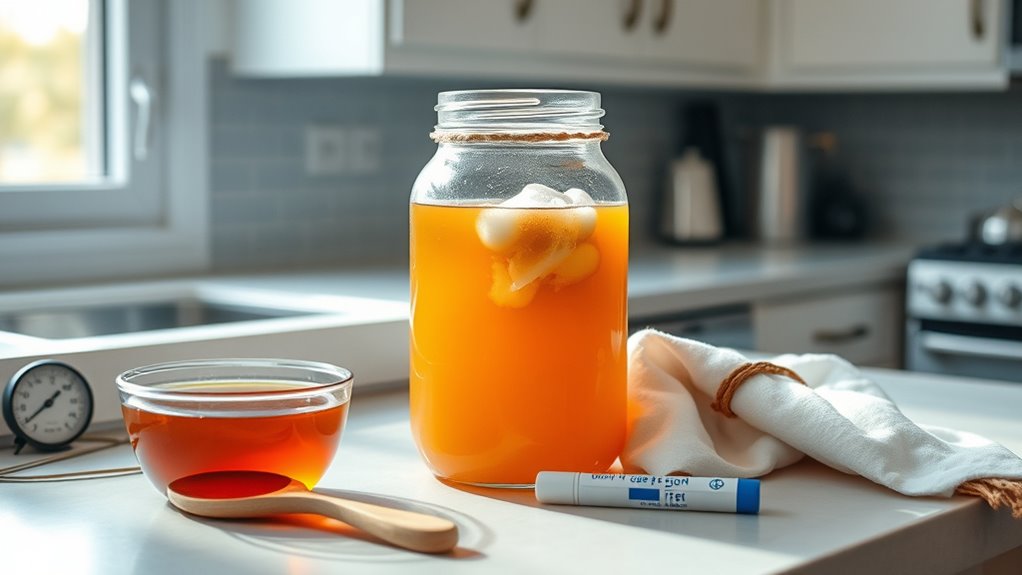To brew kombucha safely at home, focus on maintaining cleanliness by sanitizing all equipment and using high-quality, filtered water and organic ingredients. Keep your fermentation environment at the right temperature and monitor it regularly to prevent mold or spoilage. Handle your SCOBY carefully with sanitized hands and containers, and store your bottled kombucha properly, burping bottles to avoid explosions. Following these steps will help you make safe, delicious kombucha—keep exploring for detailed guidelines.
Key Takeaways
- Use sanitized, food-grade containers and utensils to prevent contamination during brewing.
- Maintain proper temperature (70–80°F) and monitor pH levels below 4.5 to inhibit harmful bacteria.
- Handle SCOBYs with clean hands and tools, inspecting for mold or discoloration regularly.
- Keep the brewing area clean, well-ventilated, and away from strong odors or ripening fruits.
- Sanitize bottles and store kombucha at room temperature briefly for carbonation, then refrigerate and periodically burp.
Prioritizing Cleanliness and Hygiene
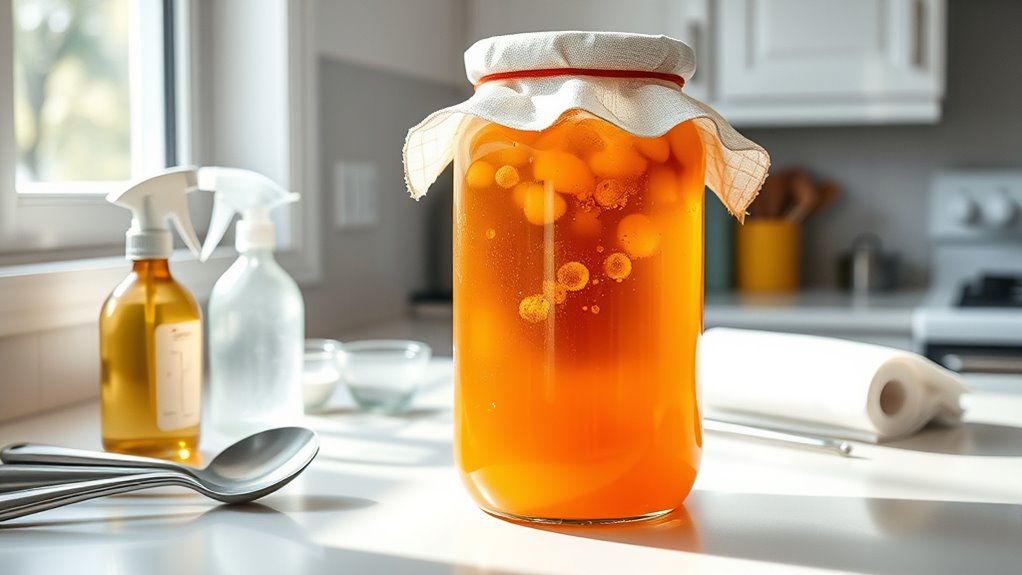
To guarantee a safe and successful batch of kombucha, you must prioritize cleanliness and hygiene throughout the brewing process. Start by thoroughly cleaning and sanitizing all utensils, jars, and surfaces to prevent contamination. Use only food-grade containers like glass, stainless steel, or ceramic—avoid plastic or decorative ceramics that can harbor bacteria. Keep your brewing area clean and well-ventilated, away from ripening fruits and strong odors that attract pests. Always cover your fermentation jar with a breathable cloth secured with a rubber band, allowing airflow while blocking insects and dust. Wear clean clothing and handle utensils with care. Regular disinfection and diligent cleaning help prevent microbial growth, mold, or foul odors, ensuring your kombucha remains safe and healthy for consumption. Maintaining a hygienic environment is essential for preventing contamination and ensuring a successful brew. Incorporating practices that reduce microbial growth can further safeguard your fermentation process. Additionally, staying informed about food safety standards can help you adhere to best practices and minimize risks. Using proper storage conditions for your finished product further preserves its quality and safety. Implementing proper airflow management can also help prevent unwanted bacterial or mold development during fermentation.
Selecting Quality Ingredients and Water
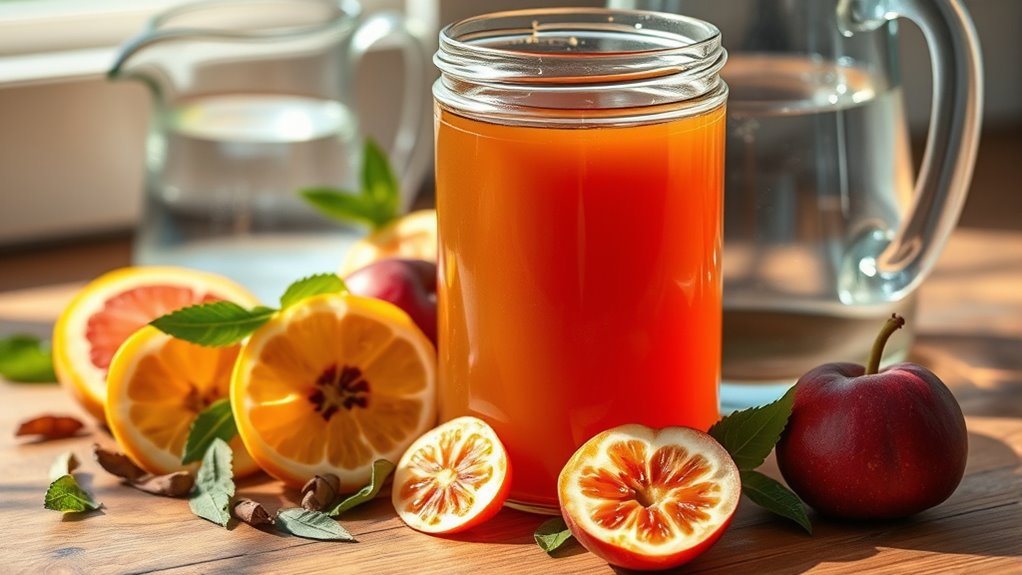
Choosing high-quality ingredients and water is essential for a successful kombucha brew. Use filtered or spring water to avoid chlorine and chloramine, which can hinder fermentation and damage your SCOBY. Proper water quality is crucial for maintaining the health of your microbial cultures and ensuring a vigorous fermentation process. Selecting pure water sources can further enhance brew consistency and prevent contamination. Select food-grade ingredients, ensuring your tea leaves are high-quality black, green, or white teas, not herbal or decaffeinated varieties, for prime nutrients. Opt for organic, non-GMO cane or beet sugar to support healthy microbes and prevent contaminants. Store all ingredients in clean, sealed containers to prevent contamination and spoilage. Always verify that your water and ingredients are free from pesticides, additives, and artificial flavors. Using quality ingredients and chlorine-free water lays a solid foundation for a safe, flavorful brew and helps maintain the health of your SCOBY throughout the fermentation process. Good farming practices can also contribute to the overall purity and safety of your ingredients. Additionally, selecting certified organic ingredients can further reduce the risk of chemical residues affecting your brew.
Proper Fermentation Environment and Monitoring
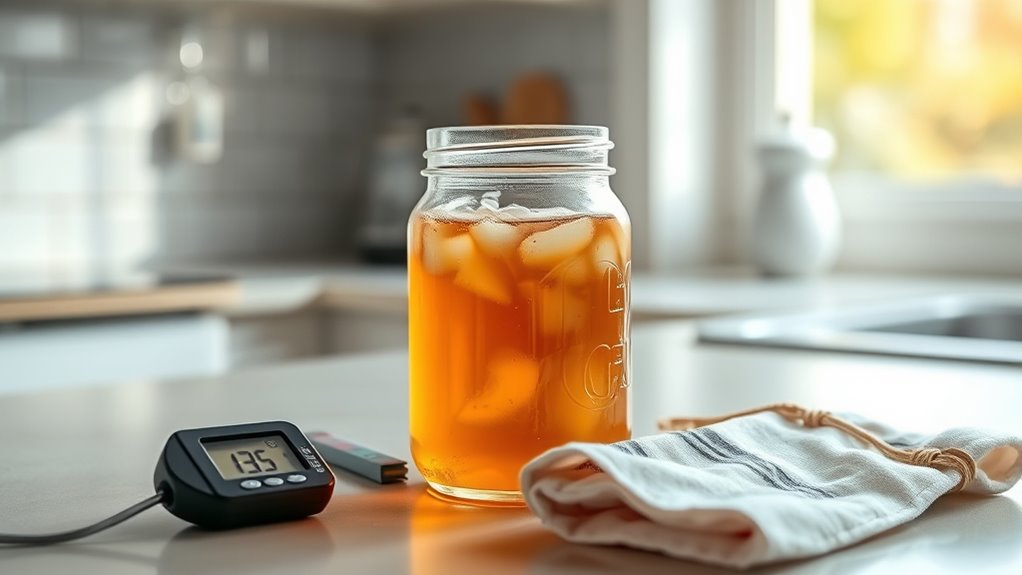
Creating the right environment for fermentation is essential to producing safe and flavorful kombucha. Your fermentation environment should stay between 70–80°F to support SCOBY activity and prevent mold. Proper temperature control is critical to prevent unwanted bacterial growth. Use a breathable cover like a cloth or coffee filter, secured with a rubber band, to allow airflow while blocking contaminants. Regularly monitor pH levels, aiming for below 4.5, to keep the environment acidic and inhibit harmful bacteria. Place your fermenter in a dark area to protect microbial activity from light exposure. Check daily for signs of spoilage, such as mold, foul odors, or fruit flies, and discard contaminated batches immediately. Ensuring proper hygiene practices and cleanliness in your brewing area also helps prevent contamination. Maintaining a stable temperature helps support SCOBY health and fermentation consistency. Consistent temperature control, along with proper monitoring, is crucial for a successful brew. Key points include:
- Maintaining proper temperature control
- Monitoring pH levels consistently
- Ensuring adequate airflow and darkness
- Watching for signs of contamination
- Promoting healthy SCOBY activity
Safe Handling of SCOBYs and Starter Liquids
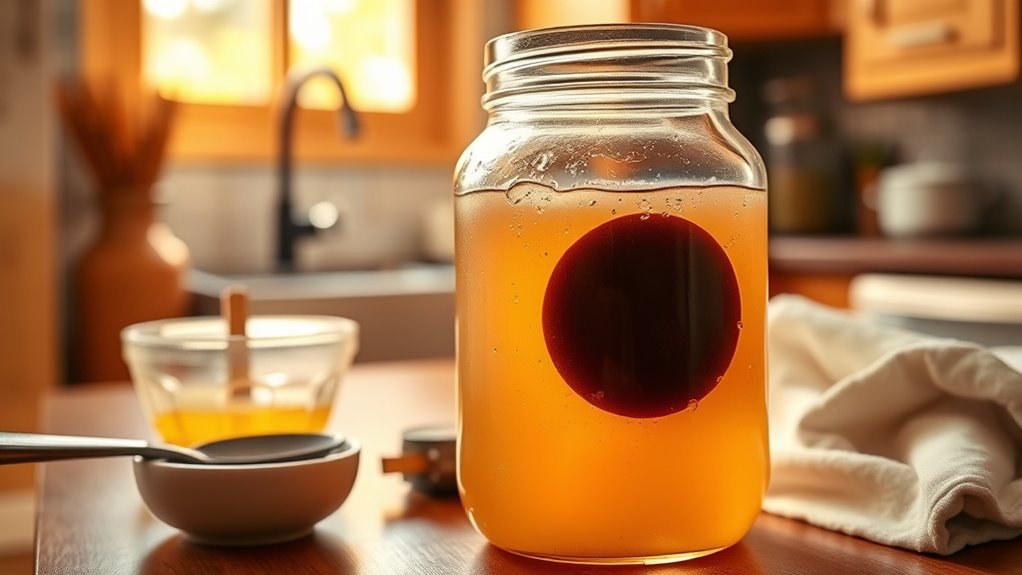
Handling SCOBYs and starter liquids safely is essential to guarantee a healthy fermentation process. Always wash your hands thoroughly and use sanitized utensils when handling the SCOBY or starter liquids to prevent contamination. Proper sanitation helps reduce contamination risks and ensures a safe brewing environment. Maintaining proper air quality around your brewing area can also prevent unwanted mold growth. Using an air purifier with a HEPA filter can help remove airborne mold spores and bacteria, creating a cleaner environment for fermentation. Store your SCOBY in a food-grade container filled with a mixture of brewed kombucha and sugar or plain kombucha to keep it healthy. Regularly inspecting your SCOBY and starter liquids for mold or unusual discoloration—fuzzy, green, black, or pink growths—indicates contamination, and these should be discarded. Ensuring your brewing environment maintains consistent temperature and cleanliness can also promote healthy SCOBY development. Use only non-reactive containers like glass or stainless steel to avoid any chemical reactions that could compromise fermentation quality.
Bottling, Storage, and Preventing Contamination
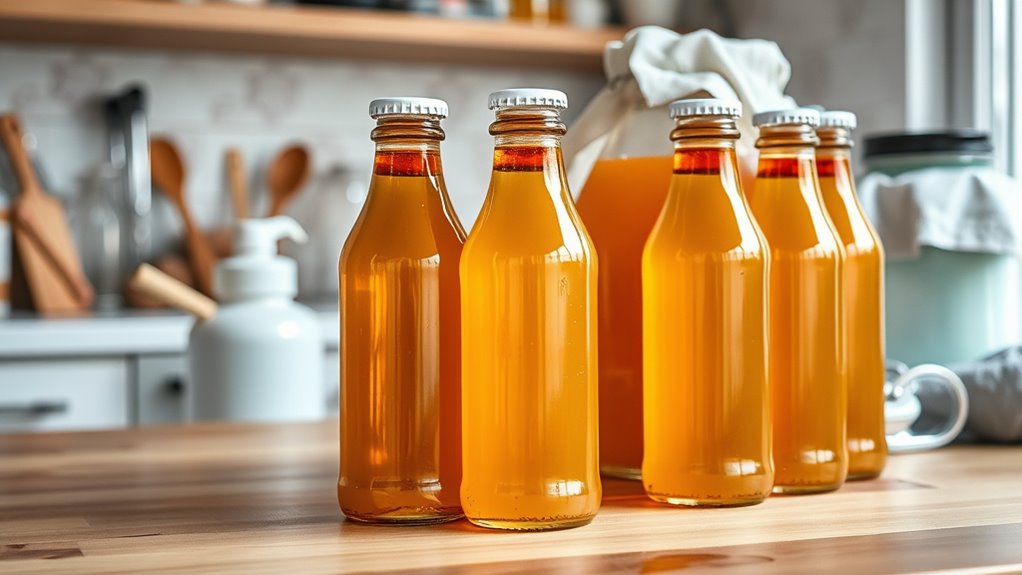
Once your kombucha has fermented to your liking, proper bottling and storage practices guarantee your brew stays safe and flavorful. Use airtight bottles with plastic or silicone caps to prevent contamination and control pressure during fermentation. Sanitizing your equipment is crucial to avoid introducing harmful bacteria or mold during the process. Fill bottles almost to the top, leaving about an inch of headspace to maximize carbonation and reduce mold risk. During storage, keep bottles at room temperature for 1–5 days to develop carbonation, then refrigerate to halt fermentation. Always cap bottles tightly and burp them periodically to release excess pressure and prevent explosions. Proper fermentation techniques are essential for ensuring the safety and quality of your homemade kombucha. Keep your storage area clean, avoid direct sunlight, and sanitize utensils and bottles regularly. These steps help prevent contamination, mold growth, and ensure your kombucha remains safe, fizzy, and delicious. Additionally, indoor gardening principles can be applied to create a clean and organized brewing environment that minimizes risks of mold and bacteria, aligning with the importance of market growth projections in maintaining a safe brewing space. Maintaining proper storage conditions can also extend the shelf life of your kombucha and preserve its flavor profile.
Frequently Asked Questions
Is Brewing Your Own Kombucha Safe?
Brewing your own kombucha can be safe if you follow proper guidelines. You need to maintain good hygiene, use sanitized equipment, and keep the brew at the right temperature.
Use filtered water and high-quality ingredients, and regularly check for mold or unusual changes.
Is It Safe to Drink the Yeast in Kombucha?
You might wonder if it’s safe to drink the yeast in kombucha. Generally, yes, the yeast is safe in small amounts and adds beneficial probiotics, flavor, and carbonation.
Just make certain your brewing process is clean and controlled to prevent contamination or mold. If your kombucha smells off or shows mold, discard it.
If you’re yeast-sensitive or immunocompromised, check with a healthcare professional before drinking.
Why Do I Feel Weird After Drinking Kombucha?
You might feel weird after drinking kombucha because it contains natural alcohol from fermentation, which can cause mild intoxication if you’re sensitive. The organic acids and probiotics can temporarily upset your gut balance, leading to bloating or lightheadedness.
If your kombucha was improperly fermented or stored, it could have higher alcohol or bacterial levels, making you feel off. Overdoing it or drinking very strong kombucha can also cause nausea or dizziness.
How Do You Pasteurize Kombucha at Home?
You might worry about losing probiotics when pasteurizing, but it’s a safe way to prevent unwanted microbes.
To do it, pour your finished kombucha into a heat-safe container, then heat gently to 140°F (60°C) using a double boiler or stovetop—avoid boiling.
Hold it there for 10 seconds, then transfer to sterilized bottles, cool quickly, and refrigerate.
This guarantees safety while keeping your kombucha fresh and drinkable.
Conclusion
So, go ahead and brew your kombucha at home—just don’t forget that cleanliness and quality are your best friends. After all, nothing says “delicious” like risking your health for a fizzy beverage. Remember, a little caution keeps the SCOBY happy and your gut happier. Who knew that brewing kombucha could be so high-stakes? Cheers to safe sipping—because your stomach deserves a little more than an experimental science project!
